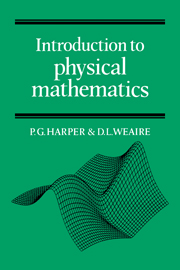Book contents
- Frontmatter
- Contents
- Preface
- Some notes on notation
- 1 Introduction
- 2 Errors
- 3 Cartesian coordinates
- 4 Vectors
- 5 The scalar product
- 6 The vector product and rotation
- 7 Matrices in physics
- 8 The transformation of matrices
- 9 The matrix eigenvalue equation
- 10 Exponential and logarithm functions
- 11 Sine and cosine functions
- 12 Graph plotting and curve sketching
- 13 Differentiation
- 14 Approximations
- 15 Power series and Taylor's expansion
- 16 Partial differentiation
- 17 Integration
- 18 The differential equation
- 19 Solving first-order differential equations
- 20 Second-order differential equations
- 21 Solving second-order differential equations
- 22 The complex exponential
- 23 The circuit equation
- 24 Harmonics and Fourier series
- 25 The diffusion equation
- 26 Waves
- 27 The rate of change of a vector
- 28 The scalar field and gradient operator
- 29 The vector field
- 30 Line integration
- 31 The potential field
- 32 Surface and volume integration
- 33 Flux and divergence
- 34 Circulation and the curl
- 35 Conclusion
- 36 Miscellaneous exercises
- Index
15 - Power series and Taylor's expansion
Published online by Cambridge University Press: 20 October 2009
- Frontmatter
- Contents
- Preface
- Some notes on notation
- 1 Introduction
- 2 Errors
- 3 Cartesian coordinates
- 4 Vectors
- 5 The scalar product
- 6 The vector product and rotation
- 7 Matrices in physics
- 8 The transformation of matrices
- 9 The matrix eigenvalue equation
- 10 Exponential and logarithm functions
- 11 Sine and cosine functions
- 12 Graph plotting and curve sketching
- 13 Differentiation
- 14 Approximations
- 15 Power series and Taylor's expansion
- 16 Partial differentiation
- 17 Integration
- 18 The differential equation
- 19 Solving first-order differential equations
- 20 Second-order differential equations
- 21 Solving second-order differential equations
- 22 The complex exponential
- 23 The circuit equation
- 24 Harmonics and Fourier series
- 25 The diffusion equation
- 26 Waves
- 27 The rate of change of a vector
- 28 The scalar field and gradient operator
- 29 The vector field
- 30 Line integration
- 31 The potential field
- 32 Surface and volume integration
- 33 Flux and divergence
- 34 Circulation and the curl
- 35 Conclusion
- 36 Miscellaneous exercises
- Index
Summary
The heart of most qualitative description of physical systems is the mathematical function, expressing the dependence of one variable quantity upon another. The named (or ‘special’) functions dealt with so far – the exponential, logarithm, cosine, and related functions – constitute a basic set of tools for describing functions. Their use can be extended enormously by combining them in various ways, so that in principle there is very little functional behaviour that they cannot represent. But for many purposes it is more convenient to specify additional functions. Often these are solutions of differential equations (chapters 18–20). By such means, further important named functions are introduced into the mathematical vocabulary, such as Bessel, Legendre, hypergeometric, and so on. The definition and systematisation of a whole class of named and related functions is often pursued through their representation by Taylor (or MacLaurin) series.
But such power series have more direct practical uses for the physicist, namely to approximate functions in numerical calculations when the linear approximation of the last chapter becomes inadequate but only a few additional powers are needed. Sometimes experimental data is confined to such a range and the goal of measurement is to find the first few coefficients of a power series.
- Type
- Chapter
- Information
- Introduction to Physical Mathematics , pp. 99 - 107Publisher: Cambridge University PressPrint publication year: 1985

